
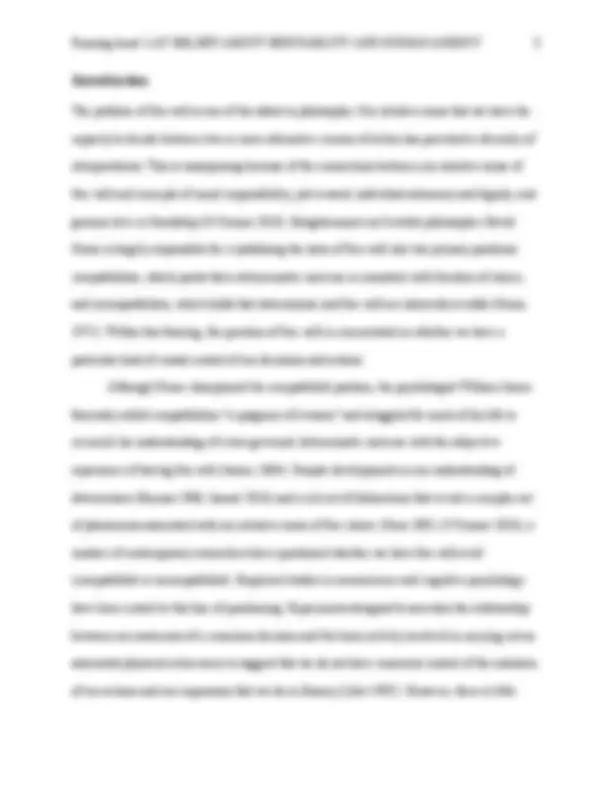
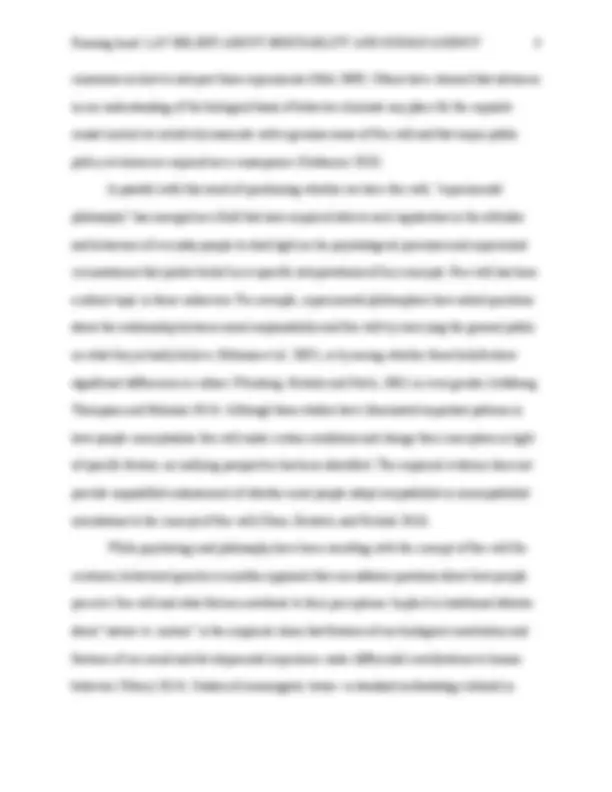

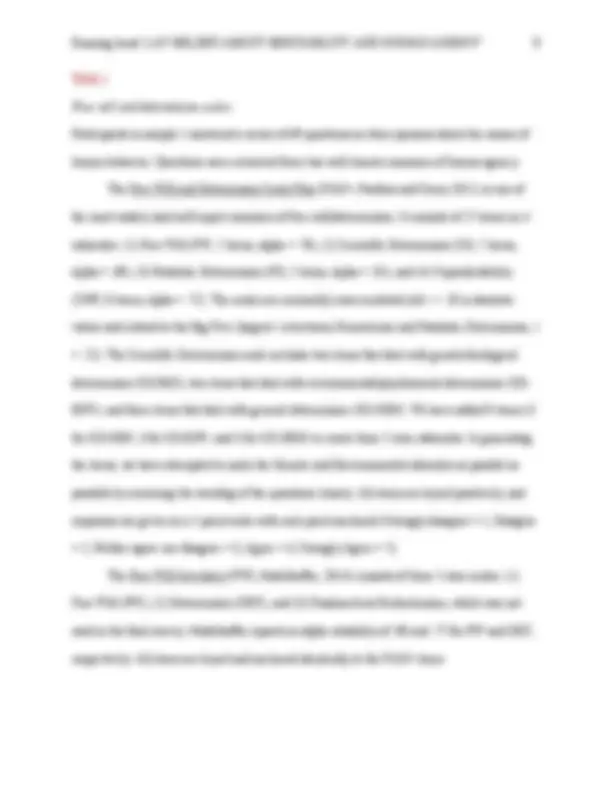
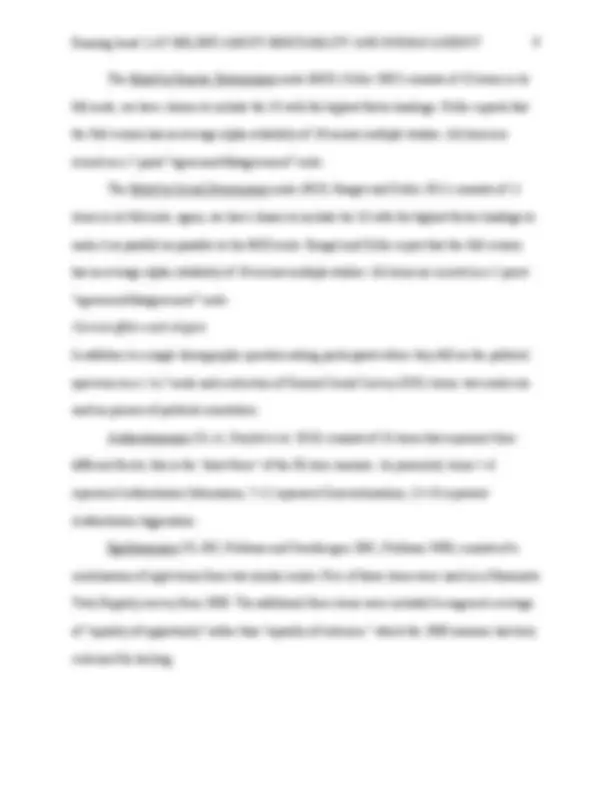
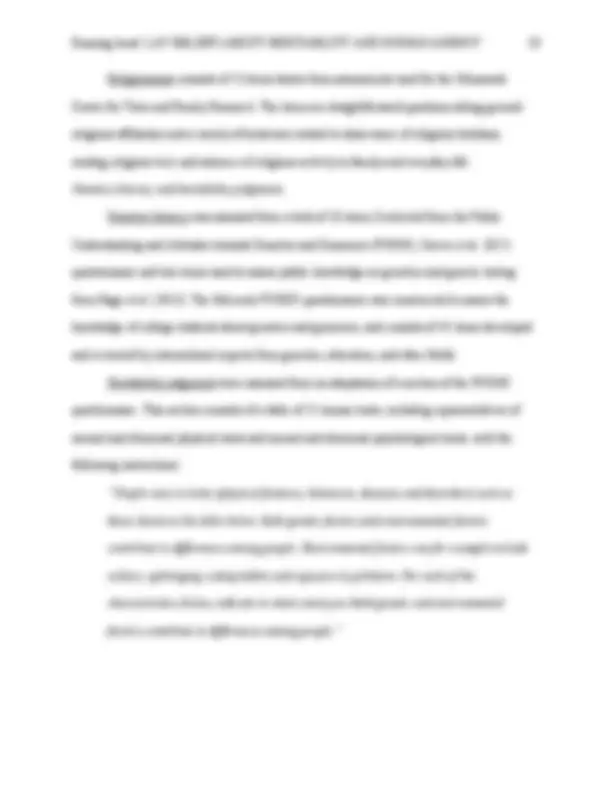
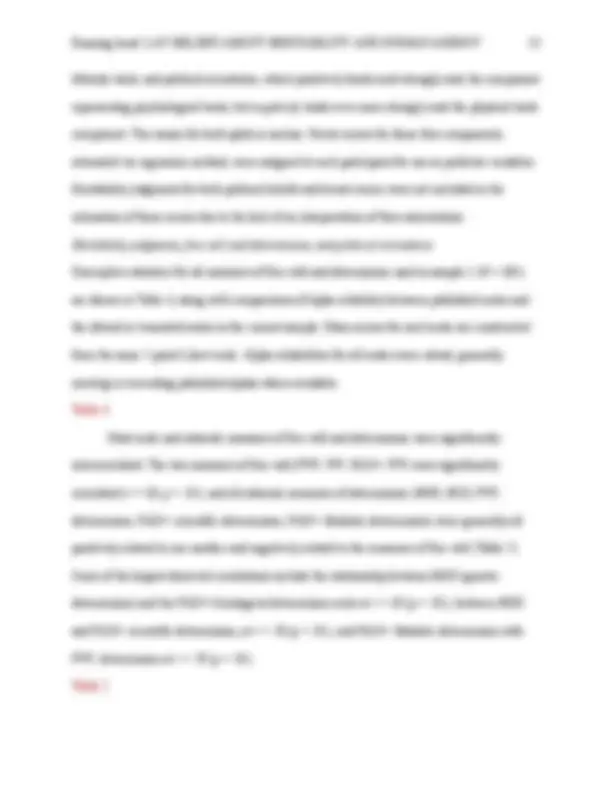
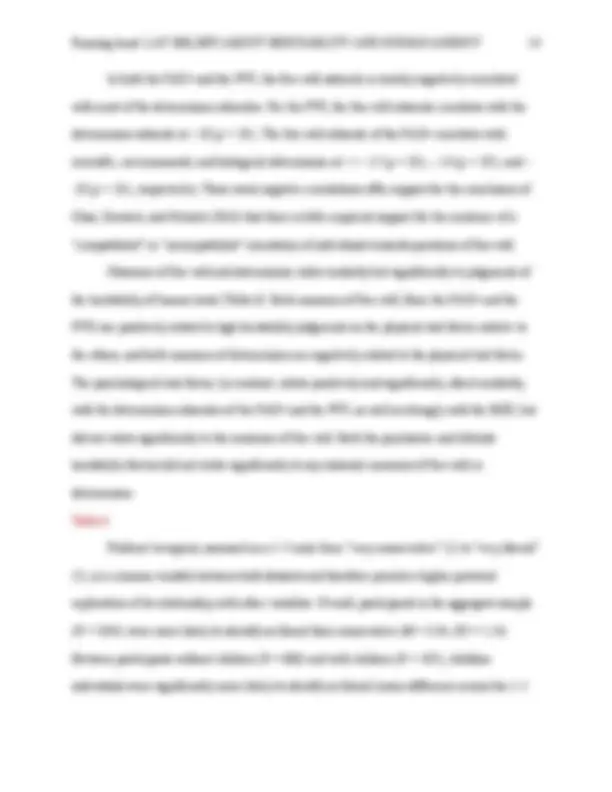
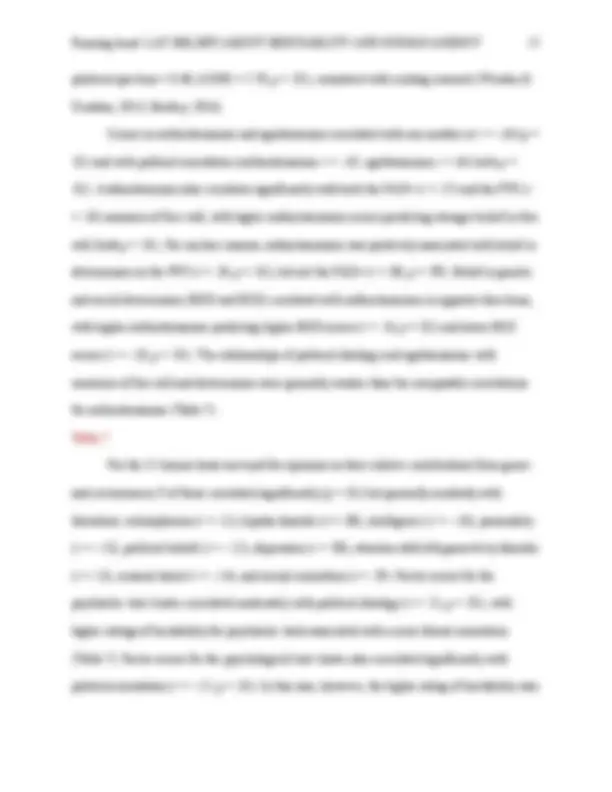
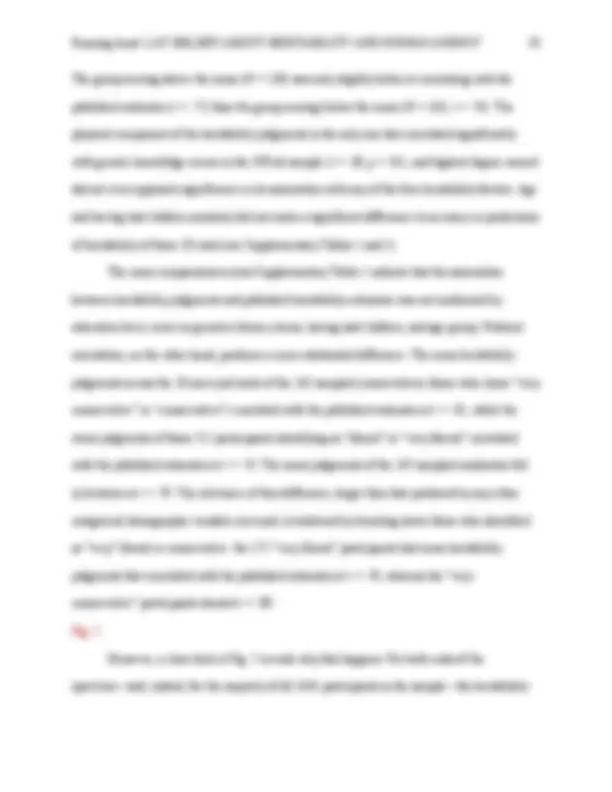
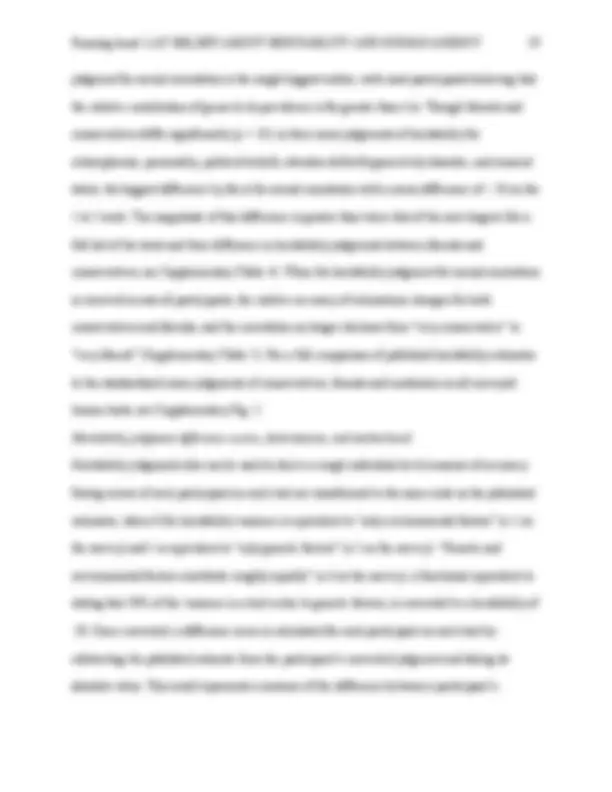
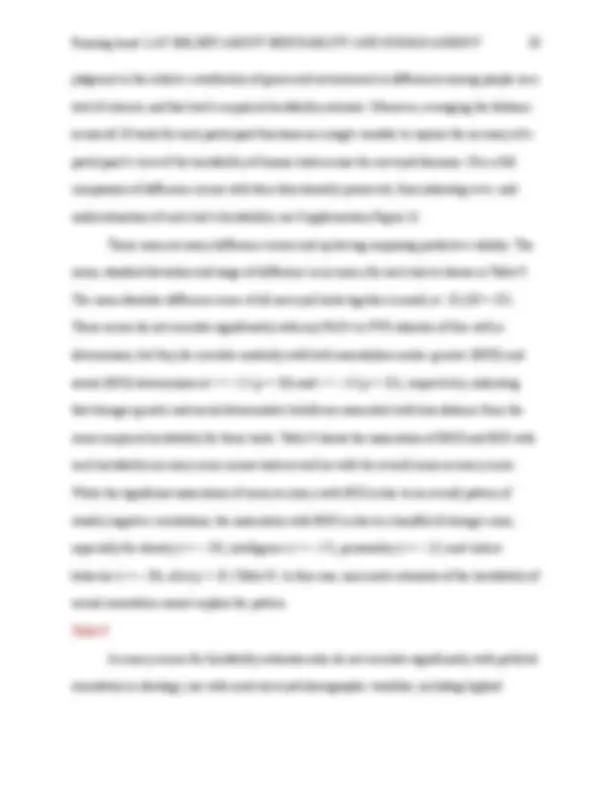
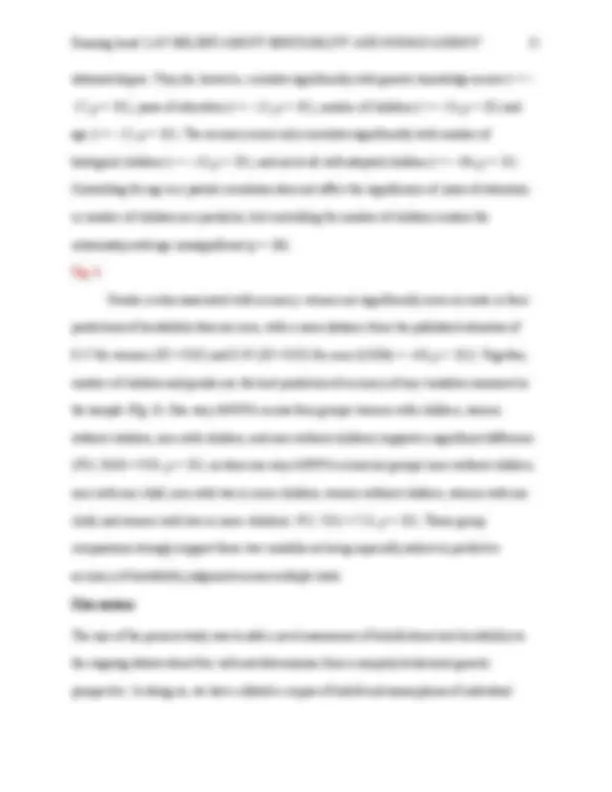
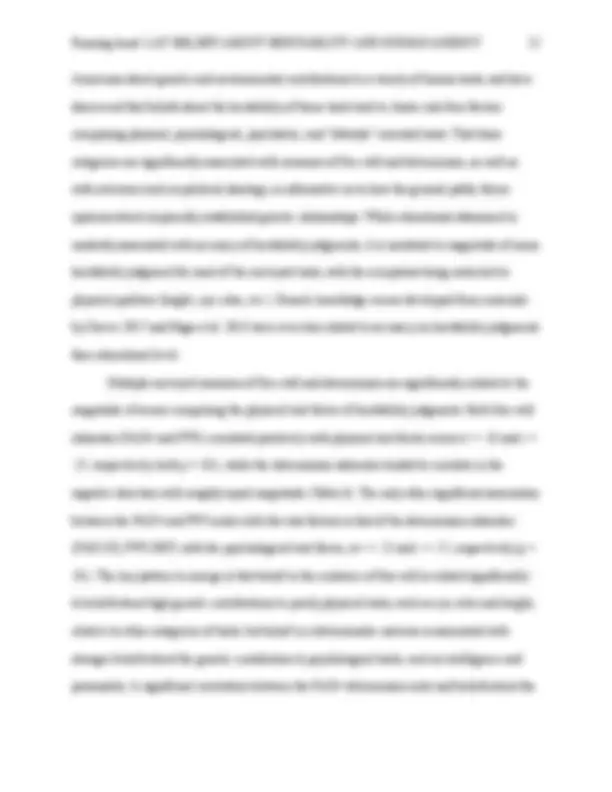
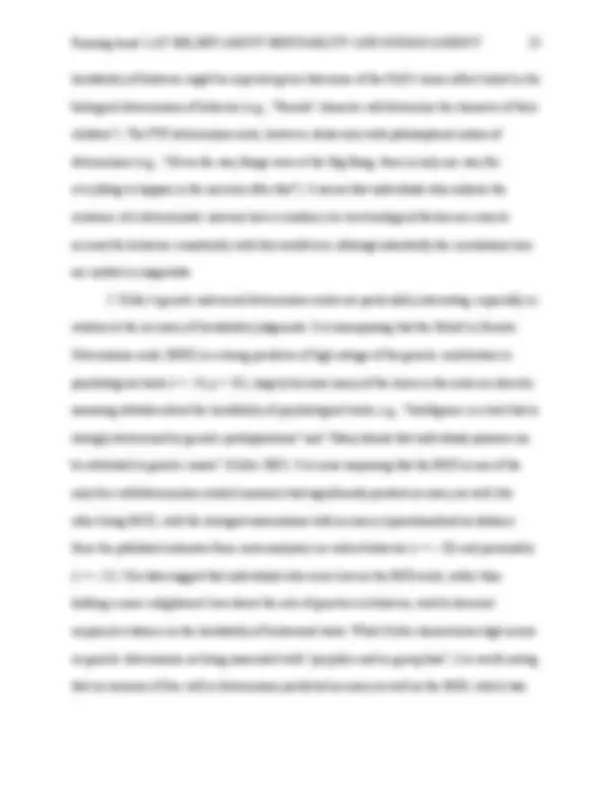
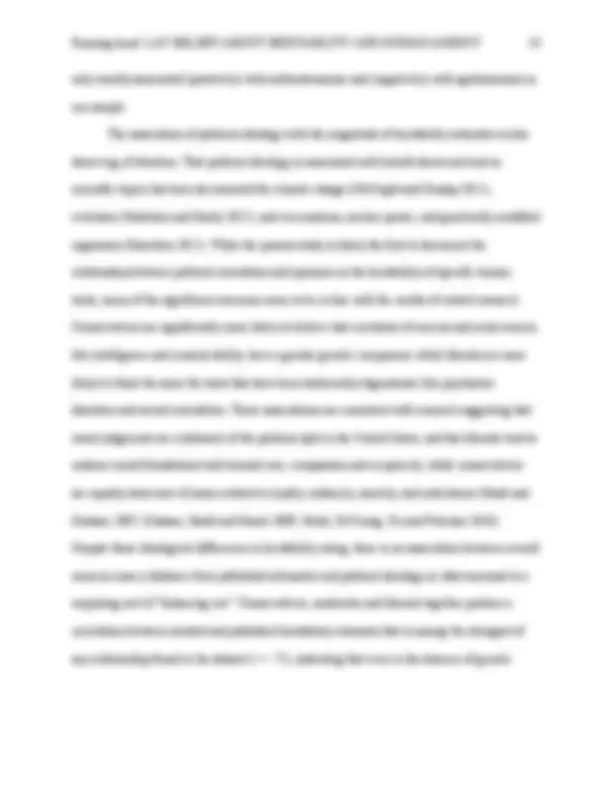


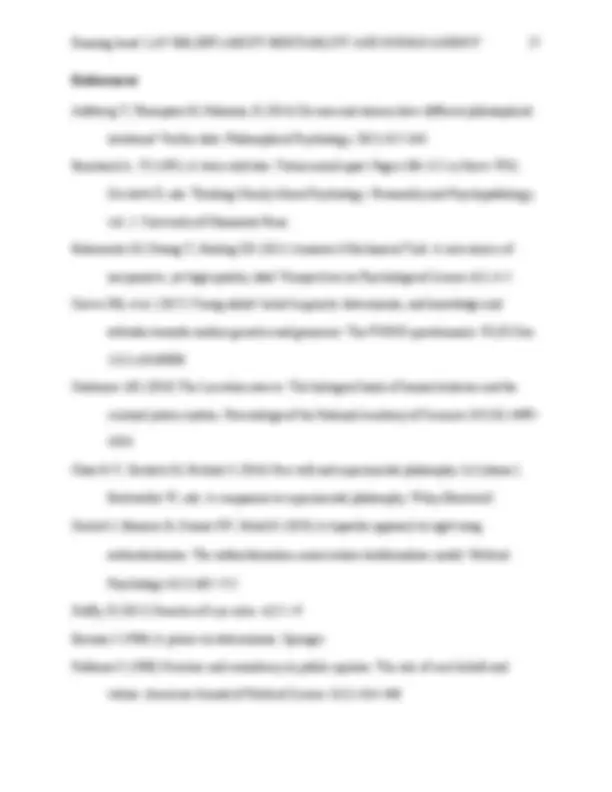


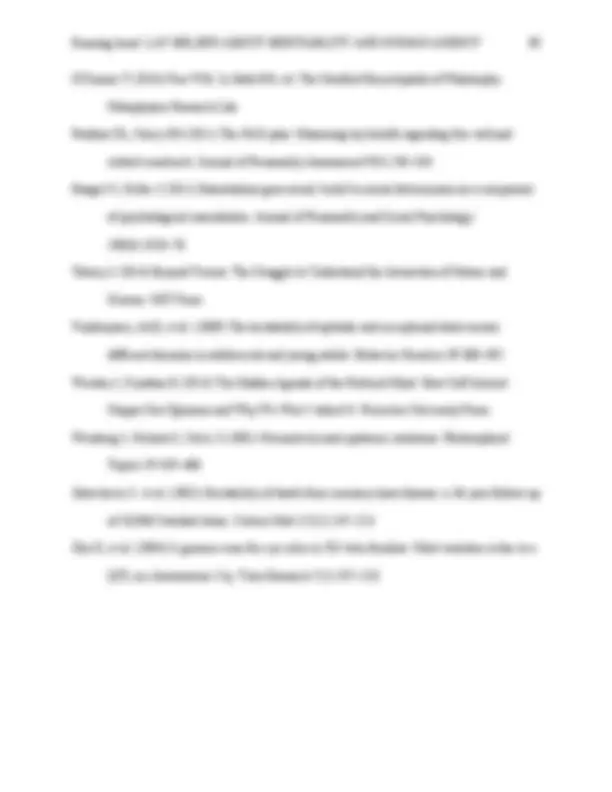
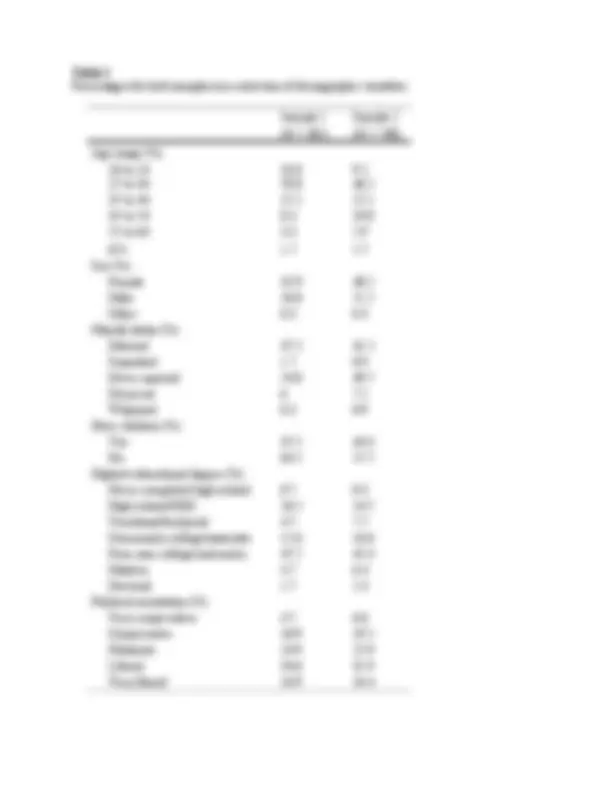
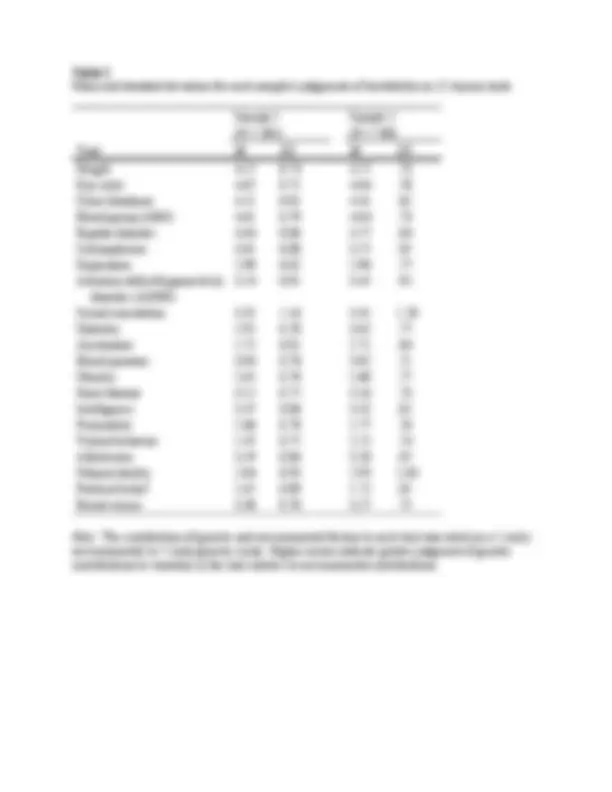
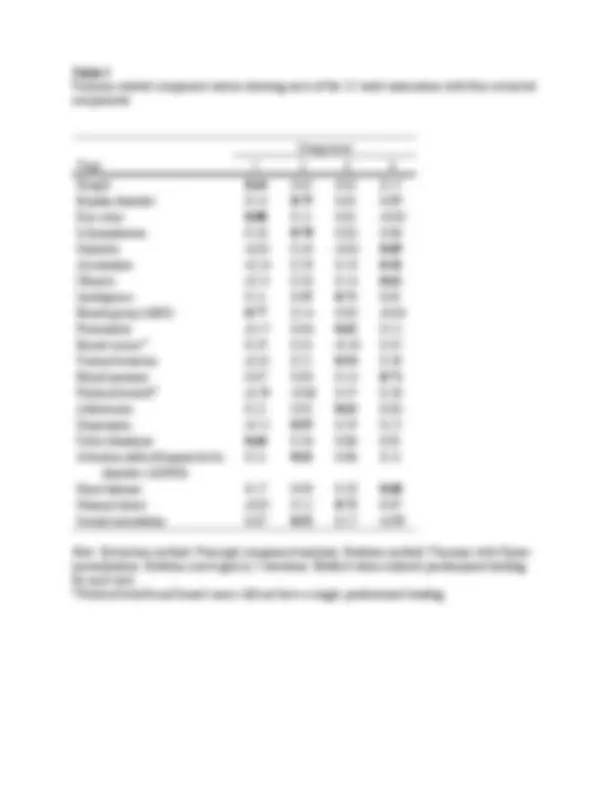

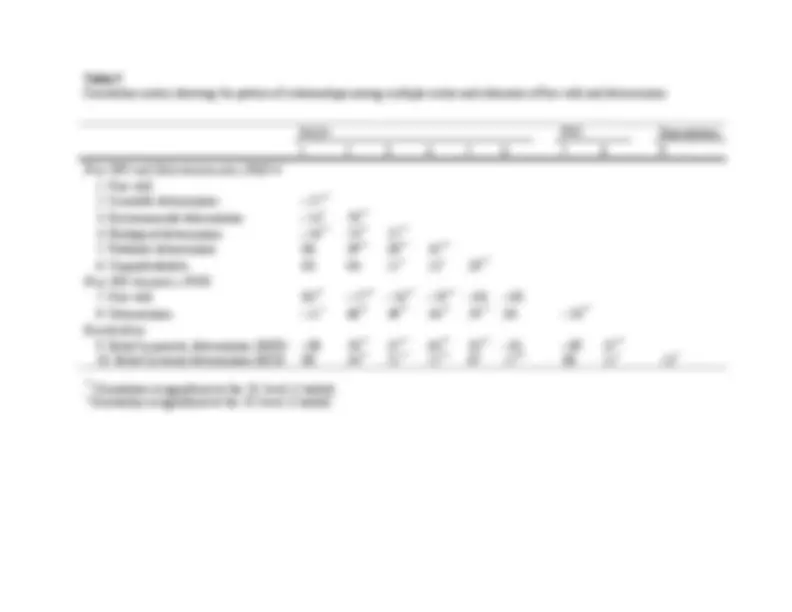
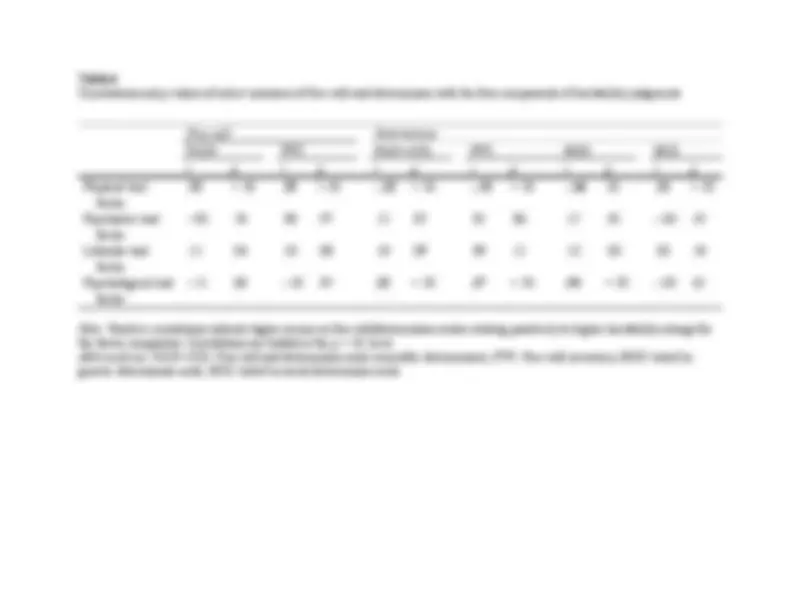
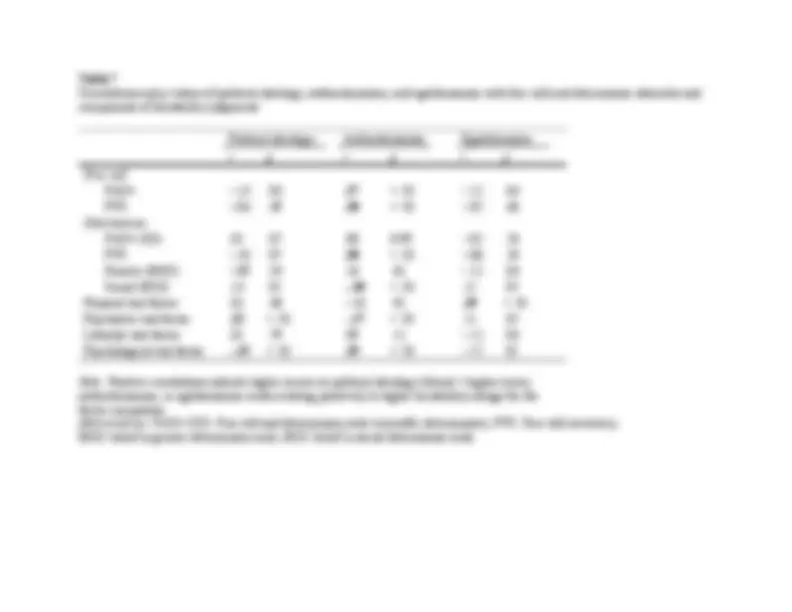
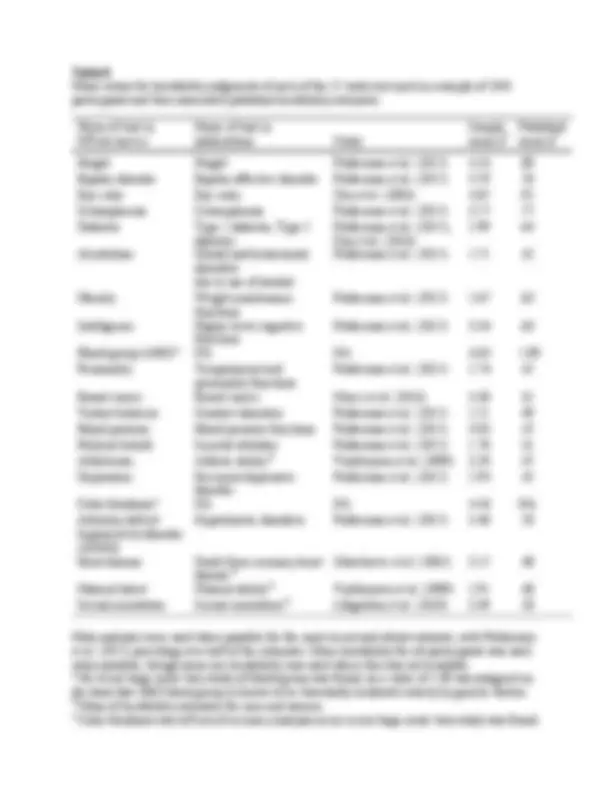
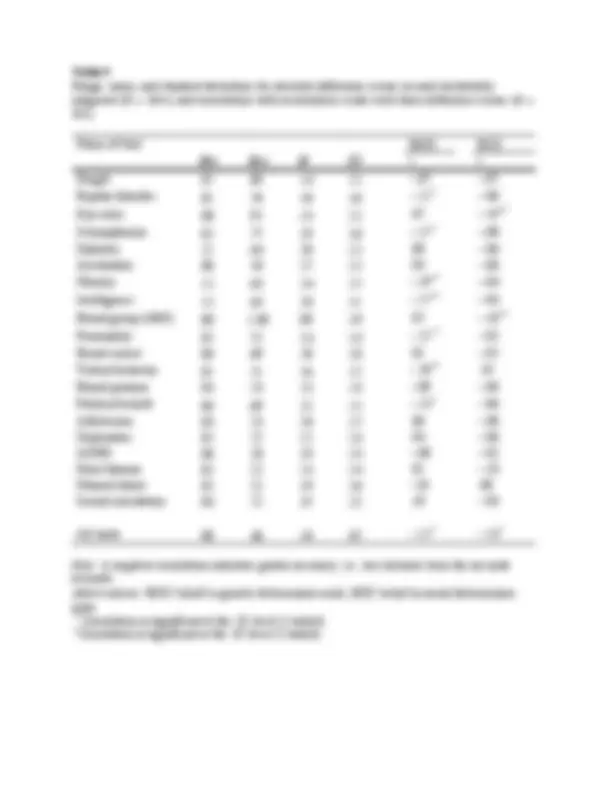
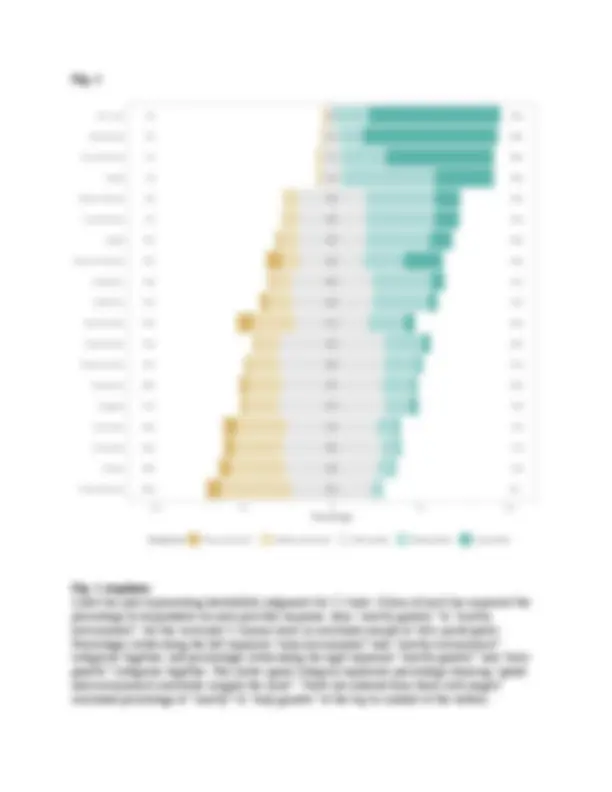
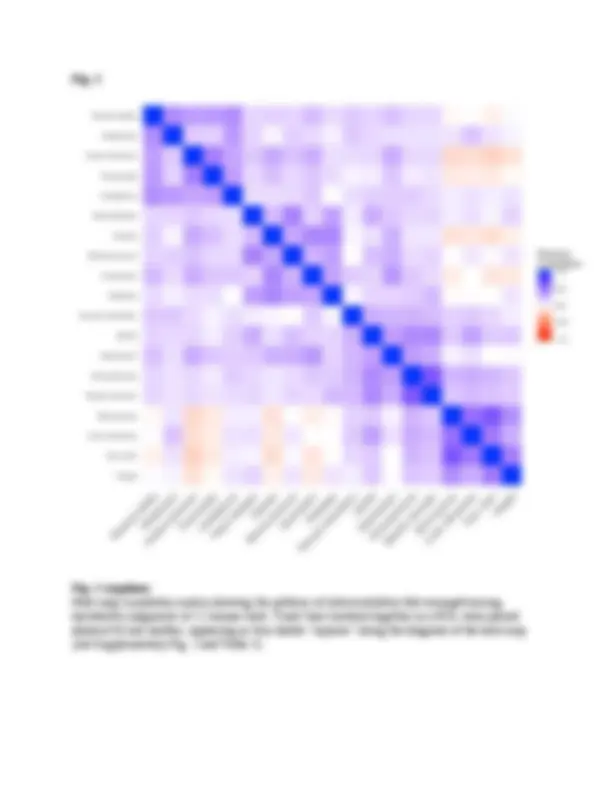
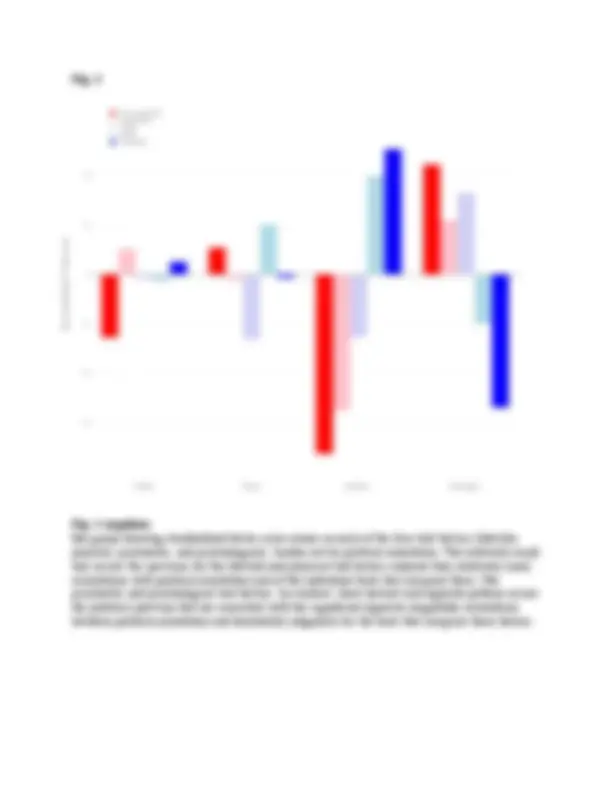
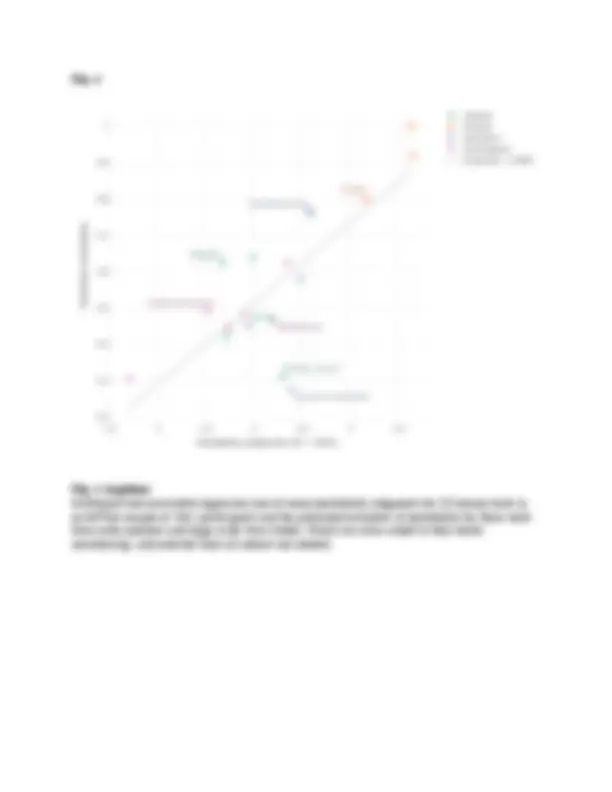
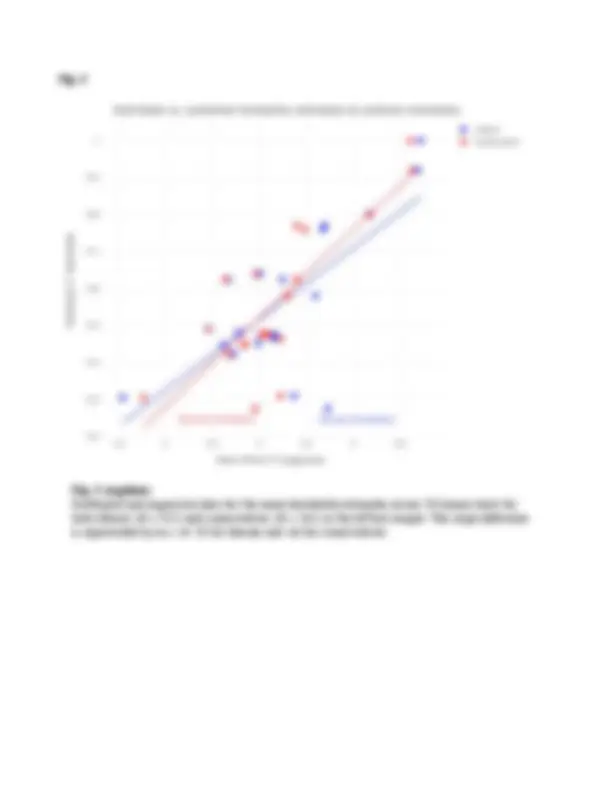
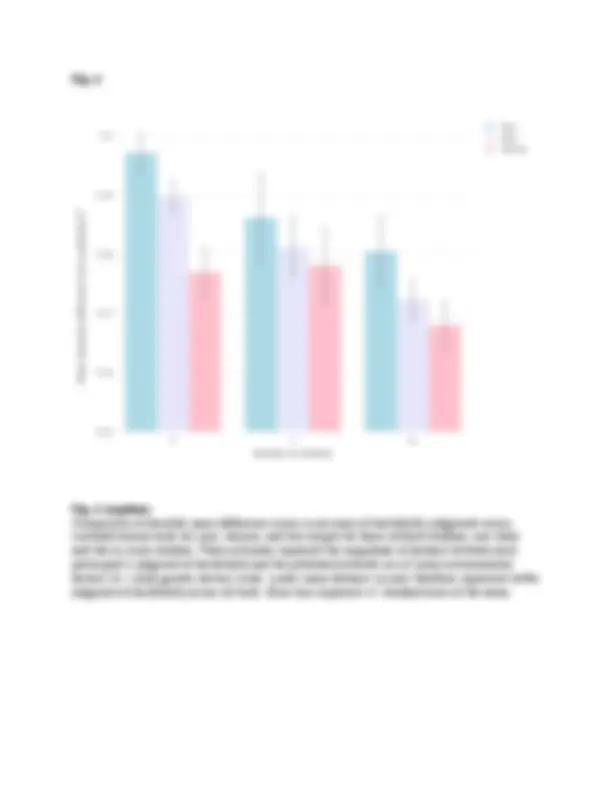


Study with the several resources on Docsity

Earn points by helping other students or get them with a premium plan


Prepare for your exams
Study with the several resources on Docsity

Earn points to download
Earn points by helping other students or get them with a premium plan
Community
Ask the community for help and clear up your study doubts
Discover the best universities in your country according to Docsity users
Free resources
Download our free guides on studying techniques, anxiety management strategies, and thesis advice from Docsity tutors
A research article that explores the relationship between beliefs about free will, determinism, and the heritability of human traits. The study surveyed two independent samples to assess attitudes towards free will, determinism, political orientation, and the relative contribution of genes and environment to 21 human traits. The authors found that belief in genetic determinism is a modest predictor of accuracy in these judgments.
Typology: Study notes
1 / 45

This page cannot be seen from the preview
Don't miss anything!






































Free will, determinism, and intuitive judgments about the heritability of behavior Emily A. Willoughby^1 Alan C. Love 2 Matt McGue^1 Jack Quigley 1 James J. Lee 1 Correspondence concerning this article should be addressed to Emily Willoughby (willo074@umn.edu), 75 East River Rd., Minneapolis, MN 55455, office phone 612 - 625 - 6881. (^1) Department of Psychology, University of Minnesota Twin Cities, Minneapolis, MN, USA (^2) Department of Philosophy, University of Minnesota Twin Cities, Minneapolis, MN, USA
The fact that genes and environment contribute differentially to variation in human behaviors, traits and attitudes is central to the field of behavior genetics. To the public, perceptions about these differential contributions may affect ideas about human agency. We surveyed two independent samples (N = 301 and N = 740) to assess beliefs about free will, determinism, political orientation, and the relative contribution of genes and environment to 21 human traits. We find that beliefs about the heritability of these traits cluster into four distinct groups, which differentially predict both beliefs about human agency and political orientation. Despite apparent ideological influences on these beliefs, the correspondence between lay judgments of heritabilities and published estimates is large ( r = .77). Belief in genetic determinism emerges as a modest predictor of accuracy in these judgments. Additionally, educated mothers with multiple children emerge as particularly accurate in their judgments of the heritabilities of these traits.
Heritability, free will, determinism, human agency, genetics, environment
consensus on how to interpret these experiments (Mele 2009). Others have claimed that advances in our understanding of the biological basis of behavior eliminate any place for the requisite causal control we intuitively associate with a genuine sense of free will and that major public policy revisions are required as a consequence (Cashmore 2010). In parallel with this trend of questioning whether we have free will, “experimental philosophy” has emerged as a field that uses empirical data to seek regularities in the attitudes and behaviors of everyday people to shed light on the psychological processes and experiential circumstances that predict belief in or specific interpretations of key concepts. Free will has been a salient topic in these endeavors. For example, experimental philosophers have asked questions about the relationship between moral responsibility and free will by surveying the general public on what they actually believe (Nahmias et al. 2005), or by seeing whether these beliefs show significant differences in culture (Weinberg, Nichols and Stitch, 2001) or even gender (Adleberg, Thompson and Nahmias 2014). Although these studies have illuminated important patterns in how people conceptualize free will under certain conditions and change their conception in light of specific factors, no unifying perspective has been identified. The empirical evidence does not provide unqualified endorsement of whether most people adopt compatibilist or incompatibilist orientations to the concept of free will (Chan, Deutsch, and Nichols 2016). While psychology and philosophy have been wrestling with the concept of free will for centuries, behavioral genetics is another approach that can address questions about how people perceive free will and what factors contribute to their perceptions. Implicit in traditional debates about “nature vs. nurture” is the empirical claim that features of our biological constitution and features of our social and developmental experience make differential contributions to human behavior (Tabery 2014). Studies of monozygotic twins—a standard methodology utilized in
behavior genetics—have shown for decades that twins can exhibit uncanny similarities as a direct consequence of genetic similarity. These studies also tend to engender a fascination with free will: I am often asked, “Given your experience with identical twins reared apart, what is your feeling about determinism and free will?” This is an interesting question. Observation of similarity between twins reared apart constantly stimulated me to ponder the problem of genetic determinism. I am not prepared to even attempt to try to answer the question. (Bouchard 1991, p. 311) Intriguingly, the relationship between our intuitions about free will and knowledge about the heritability of human traits has remained largely unstudied. For example, on the standard framing of compatibilism versus incompatibilism, a deterministic universe would have the same logical implications for free will regardless of whether genes or environment are more responsible for determining our behavior. And yet it seems plausible that people might have different intuitions about how these types of causal factors are related to the concept of free will. This suggests that a behavioral genetic approach is uniquely equipped to answer two important questions in this vein: (1) how do attitudes about free will and determinism relate to what people believe about the genetic and environmental contributions to behavior?, and, (2) what influences do genetic and environmental factors actually have on beliefs about free will and determinism? The present study explores answers to (1) with a survey of two large American samples with the long-term aim of answering (2) by looking at beliefs about free will and determinism in a sample of adoptive and biological families with a genetically-sensitive design. Surveying over 1000 participants on Amazon Mechanical Turk, we examine the
by including several validity-check items, as well as by limiting participants to a HIT approval rate of 90% or greater and the number of lifetime HITs approved to 100 or greater. Participants had to be at least 18 years old and located in the United States. The final sample of the first study (sample 1) consisted of 301 participants (42.9% female) with 50.8% falling within the “25 to 34” age range. No participants were excluded on the basis of failed validity checks or incomplete answers. A total of 68 participants responded to both surveys, and their responses on the second survey were removed from the final analyses. Participants in the second study (sample 2) consisted of 740 unique participants (48.2% female) with 46.2% falling within the “25 to 34” age range. Measures Samples 1 and 2 differed markedly in the range of measures employed across the surveys. Sample 1 (N = 301) evaluated participants on a suite of 9 demographic questions and 184 questions assessing personality, religion, knowledge of basic genetics, and attitudes toward current affairs and the causes of human behavior. Sample 2 (N = 740) evaluated participants on a total of 11 demographic questions and 21 questions assessing attitudes about the contributions of genes and environment to various human traits. Demographics Both samples of participants responded to a demographic section that assessed age range, gender, marital status, educational degree, years of education, working status, hours worked in a week, and political views. The survey administered to sample 2 included additional questions on range of household income and number of adopted and biological male and female children for each participant. Demographic distributions were similar for most variables across the two samples. Demographic comparison of the two samples is summarized in Table 1.
Table 1 Free will and determinism scales Participants in sample 1 answered a series of 69 questions on their opinions about the causes of human behavior. Questions were extracted from two well-known measures of human agency. The Free Will and Determinism Scale-Plus (FAD+; Paulhus and Carey 2011 ) is one of the most widely used self-report measures of free will/determinism. It consists of 27 items on 4 subscales: (1) Free Will (FW; 7 items, alpha = .70), (2) Scientific Determinism (SD; 7 items, alpha = .69), (3) Fatalistic Determinism (FD; 5 items, alpha = .82), and (4) Unpredictability (UNP; 8 items, alpha = .72). The scales are minimally intercorrelated (all r < .20 in absolute value) and related to the Big Five (largest r is between Neuroticism and Fatalistic Determinism, r = .22). The Scientific Determinism scale includes two items that deal with genetic/biological determinism (SD-BIO), two items that deal with environmental/psychosocial determinism (SD- ENV), and three items that deal with general determinism (SD-GEN). We have added 9 items ( for SD-GEN, 3 for SD-ENV, and 3 for SD-GEN) to create three 5-item subscales. In generating the items, we have attempted to make the Genetic and Environmental subscales as parallel as possible by mirroring the wording of the questions closely. All items are keyed positively, and responses are given on a 5-point scale with each point anchored (Strongly disagree = 1, Disagree = 2, Neither agree nor disagree = 3, Agree = 4, Strongly Agree = 5). The Free Will Inventory (FWI; Nadelhoffer, 2014) consists of three 5-item scales: (1) Free Will (FW), (2) Determinism (DET), and (3) Dualism/Anti-Reductionism, which was not used in the final survey. Nadelhoffer reports an alpha reliability of .80 and .77 for FW and DET, respectively. All items are keyed and anchored identically to the FAD+ items.
Religiousness consists of 13 items drawn from assessments used for the Minnesota Center for Twin and Family Research. The items are straightforward questions asking general religious affiliation and a variety of behaviors related to observance of religious holidays, reading religious text, and salience of religious activity in family and everyday life. Genetics literacy and heritability judgments Genetics literacy was assessed from a total of 10 items, 8 selected from the Public Understanding and Attitudes towards Genetics and Genomics (PUGGS; Carver et al. 2017) questionnaire and two items used to assess public knowledge on genetics and genetic testing from Haga et al. ( 2013 ). The full-scale PUGGS questionnaire was constructed to assess the knowledge of college students about genetics and genomics, and consists of 45 items developed and reviewed by international experts from genetics, education, and other fields. Heritability judgments were assessed from an adaptation of a section of the PUGGS questionnaire. This section consists of a table of 21 human traits, including representatives of normal and abnormal physical traits and normal and abnormal psychological traits, with the following instructions: “People vary in traits (physical features, behaviors, diseases and disorders) such as those shown in the table below. Both genetic factors and environmental factors contribute to differences among people. Environmental factors can for example include culture, upbringing, eating habits and exposure to pollution. For each of the characteristics below, indicate to what extent you think genetic and environmental factors contribute to differences among people.”
Responses are keyed on a 1 to 5 scale (Only environmental factors = 1, Mainly environmental factors = 2, Genetic and environmental factors contribute roughly the same = 3, Mainly genetic factors = 4, Only genetic factors = 5). Analysis All statistical analyses were conducted in SPSS and R. Reported subscale measures are all mean values of scores unless otherwise indicated. Due to the large number of variables and generally small effect sizes, significance is established at p < .01 unless otherwise indicated.
Heritability judgments Mean judgments of heritability for each trait and its variance were very similar between samples 1 and 2 for most of the surveyed traits; these are displayed for all traits in Table 2. Absolute differences in mean judgments were 0.11 or less and averaged 0.05 on the 1 to 5 scale. In both samples, participants rated differences in height, eye color, blood group, and colorblindness as the most heritable traits, with means falling above 4.0 in both studies and the highest estimates in genetic contribution for eye color (sample 1 M = 4.67, SD = 0.71; sample 2 M = 4.64, SD = 0.70) and blood group (sample 1 M = 4.61, SD = 0.79; sample 2 M = 4.64, SD = 0.73). Difference in political belief was judged to have the smallest genetic contribution in both studies, and was the only surveyed trait whose mean fell below 2.0 (sample 1 M = 1.67, SD = 0.89; sample 2 M = 1.72, SD = 0.85). Sexual orientation and political belief both had the largest spread in both samples, with standard deviations approaching or exceeding 1.0. Table 2 Since both MTurk samples included the same 21 heritability judgment questions (total unique N = 1041) and these judgments were stable, the samples were combined for most
lifestyle traits, and political orientation, which positively loads most strongly onto the component representing psychological traits, but negatively loads even more strongly onto the physical traits component. The reason for both splits is unclear. Factor scores for these four components, estimated via regression method, were assigned to each participant for use as predictor variables. Heritability judgments for both political beliefs and breast cancer were not included in the estimation of these scores due to the lack of an interpretation of their associations. Heritability judgments, free will and determinism, and political orientation Descriptive statistics for all measures of free will and determinism used in sample 1 (N = 301) are shown in Table 4, along with comparisons of alpha reliability between published scales and the altered or truncated scales in the current sample. Mean scores for each scale are constructed from the same 5-point Likert scale. Alpha reliabilities for all scales were robust, generally meeting or exceeding published alphas where available. Table 4 Most scale and subscale measures of free will and determinism were significantly intercorrelated. The two measures of free will (FWI: FW, FAD+: FW) were significantly correlated ( r = .83, p < .01), and all subscale measures of determinism (BGD, BSD, FWI: determinism, FAD+: scientific determinism, FAD+: fatalistic determinism) were generally all positively related to one another and negatively related to the measures of free will (Table 5). Some of the largest observed correlations include the relationship between BGD (genetic determinism) and the FAD+’s biological determinism scale at r = .63 ( p < .01); between BGD and FAD+: scientific determinism, at r = .58 ( p < .01), and FAD+: fatalistic determinism with FWI: determinism at r = .59 ( p < .01). Table 5
In both the FAD+ and the FWI, the free will subscale is weakly negatively correlated with most of the determinism subscales. For the FWI, the free will subscale correlates with the determinism subscale at – .18 ( p < .01). The free will subscale of the FAD+ correlates with scientific, environmental, and biological determinism at r = – .15 ( p < .01), – .14 ( p < .05), and – .18 ( p < .01), respectively. These weak negative correlations offer support for the conclusion of Chan, Deutsch, and Nichols (2016) that there is little empirical support for the existence of a “compatibilist” or “incompatibilist” orientation of individuals towards questions of free will. Measures of free will and determinism relate modestly but significantly to judgments of the heritability of human traits (Table 6). Both measures of free will (from the FAD+ and the FWI) are positively related to high heritability judgments on the physical trait factor relative to the others, and both measures of determinism are negatively related to the physical trait factor. The psychological trait factor, by contrast, relates positively and significantly, albeit modestly, with the determinism subscales of the FAD+ and the FWI, as well as strongly with the BGD, but did not relate significantly to the measures of free will. Both the psychiatric and lifestyle heritability factors did not relate significantly to any subscale measures of free will or determinism. Table 6 Political viewpoint, assessed on a 1–5 scale from “very conservative” (1) to “very liberal” (5), is a common variable between both datasets and therefore permits a higher-powered exploration of its relationship with other variables. Overall, participants in the aggregate sample (N = 1041) were more likely to identify as liberal than conservative ( M = 3.34, SD = 1.14). Between participants without children (N = 606) and with children (N = 435), childless individuals were significantly more likely to identify as liberal (mean difference across the 1– 5
by conservatives rather than liberals. This contrasting trend for both the psychiatric trait factor and the psychological trait factor is reiterated in their associations with authoritarianism (psychiatric: r = – .17, p < .01; psychological: r = .19, p < .01) and with egalitarianism (psychiatric: r = .11, p = .05; psychological: r = – .15, p < .01). See Supplementary Table 3 for a detailed breakdown of each factor and its relationship to political ideology, authoritarianism and egalitarianism. If the trait factors are considered as meaningful clusters, conservative and authoritarian attitudes tend to be more strongly associated with higher judgments of the genetic contribution to psychological traits and lower judgments of the genetic contribution to psychiatric traits, and liberal and egalitarian attitudes are typically associated with the opposite. Figure 3 illustrates the mean standardized factor scores on each of the four factors of heritability judgments of the surveyed human traits. Fig. 3 Heritability judgments and published estimates One feature of participants’ judgments of heritability for these traits may be the most interesting: their correspondence with empirical estimates of heritability. Thanks to a rich history of twin, adoption and family studies that have culminated in some recent meta-analyses, the correlation between these judgments in an MTurk sample of over a thousand participants and actual measured heritability estimates can be calculated. Table 8 Table 8 shows the mean heritability judgment for each trait in the combined sample of 1041 participants, on a 1–5 scale, compared to the best available estimate of heritability for the same or similar traits in published literature. Most estimates come from the 2015 meta-analysis by Polderman et. al, which documents the results of fifty years of twin studies on over 17,
separate traits. The name of the comparable trait used in the published literature is displayed alongside the name used in the current study. In several cases including political beliefs, violent behavior and obesity, the trait whose meta-analytic heritability estimate was used is a collection of similar traits that form a related grouping, which has been chosen on the basis of greatest similarity and inclusion of the surveyed trait. The robust prediction enabled by these collections is deemed superior over citing individual studies that might suffer from smaller independent samples. For example, since few twin studies on political orientation have been conducted, the category was chosen that included this trait within “societal attitudes.” Similarly, “violent behavior” resides comfortably within the Polderman et al. (2015) grouping of “conduct disorders.” Among the traits that were absent or too nonspecific from the Polderman et al. (2015) meta-analysis, estimates of athletic and musical ability were taken from the Vinkhuyzen et al. (2009) meta-analysis on the heritability of talents and abilities. Fig. 4 The correlation between heritability judgments and published estimates is .77 (Figure 4 ). Sexual orientation represents the largest discrepancy between lay opinion and published estimates, with a sizable majority of participants overestimating its heritability. Removing this trait from the correlation boosts it to .84. This correspondence between everyday judgments of heritability and the empirical estimates cannot be explained by education or even genetic knowledge alone. The correlation between heritability judgments and published estimates differed very little between participants with an associate’s degree or lower (N = 505, r = .77) and those with a bachelor’s degree or higher (N = 536, r = .76), and was even slightly lower in the more-educated group. Likewise, participants’ score on the genetic knowledge component of the first sample survey similarly failed to be associated with accuracy in heritability judgment.
judgment for sexual orientation is the single biggest outlier, with most participants believing that the relative contribution of genes to its prevalence is far greater than it is. Though liberals and conservatives differ significantly ( p < .01) in their mean judgments of heritability for schizophrenia, personality, political beliefs, attention deficit/hyperactivity disorder, and musical talent, the biggest difference by far is for sexual orientation with a mean difference of – .76 on the 1 to 5 scale. The magnitude of this difference is greater than twice that of the next-largest (for a full list of the traits and their difference in heritability judgments between liberals and conservatives, see Supplementary Table 4). When the heritability judgment for sexual orientation is removed across all participants, the relative accuracy of estimations changes for both conservatives and liberals, and the correlation no longer declines from “very conservative” to “very liberal” (Supplementary Table 5). For a full comparison of published heritability estimates to the standardized mean judgments of conservatives, liberals and moderates on all surveyed human traits, see Supplementary Fig. 2. Heritability judgment difference scores, determinism, and motherhood Heritability judgments also can be used to derive a rough individual-level measure of accuracy. Rating scores of each participant on each trait are transformed to the same scale as the published estimates, where 0 for heritability variance is equivalent to “only environmental factors” (a 1 on the survey) and 1 is equivalent to “only genetic factors” (a 5 on the survey). “Genetic and environmental factors contribute roughly equally” (a 3 on the survey), a functional equivalent to stating that 50% of the variance in a trait is due to genetic factors, is converted to a heritability of .50. Once converted, a difference score is calculated for each participant on each trait by subtracting the published estimate from the participant’s converted judgment and taking its absolute value. This result represents a measure of the difference between a participant’s
judgment in the relative contribution of genes and environment in differences among people on a trait of interest, and that trait’s empirical heritability estimate. Moreover, averaging the distance across all 20 traits for each participant functions as a single variable to capture the accuracy of a participant’s view of the heritability of human traits across the surveyed domains. (For a full comparison of difference scores with their directionality preserved, thus indicating over- and underestimation of each trait’s heritability, see Supplementary Figure 3). These mean accuracy difference scores end up having surprising predictive validity. The mean, standard deviation and range of difference in accuracy for each trait is shown in Table 9. The mean absolute difference score of all surveyed traits together is small, at .18 ( SD = .05). These scores do not correlate significantly with any FAD+ or FWI subscale of free will or determinism, but they do correlate modestly with both essentialism scales: genetic (BGD) and social (BSD) determinism at r = – .12 ( p = .03) and r = – .13 ( p = .02), respectively, indicating that stronger genetic and social deterministic beliefs are associated with less distance from the mean empirical heritability for these traits. Table 9 shows the association of BGD and BSD with each heritability accuracy score across traits as well as with the overall mean accuracy score. While the significant association of mean accuracy with BSD is due to an overall pattern of weakly negative correlations, the association with BGD is due to a handful of stronger ones, especially for obesity ( r = – .19), intelligence ( r = – .17), personality ( r = – .21) and violent behavior ( r = – .28), all at p < .01 (Table 9). In this case, inaccurate estimates of the heritability of sexual orientation cannot explain the pattern. Table 9 Accuracy scores for heritability estimates also do not correlate significantly with political orientation or ideology, nor with most surveyed demographic variables, including highest